chinese body language(中国人的身体语言)
- 格式:docx
- 大小:15.49 KB
- 文档页数:2
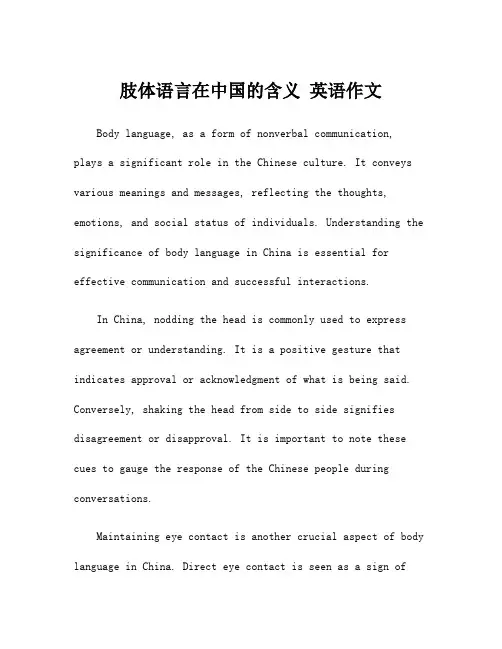
肢体语言在中国的含义英语作文Body language, as a form of nonverbal communication, plays a significant role in the Chinese culture. It conveys various meanings and messages, reflecting the thoughts, emotions, and social status of individuals. Understanding the significance of body language in China is essential for effective communication and successful interactions.In China, nodding the head is commonly used to express agreement or understanding. It is a positive gesture that indicates approval or acknowledgment of what is being said. Conversely, shaking the head from side to side signifies disagreement or disapproval. It is important to note these cues to gauge the response of the Chinese people during conversations.Maintaining eye contact is another crucial aspect of body language in China. Direct eye contact is seen as a sign ofsincerity, confidence, and respect. It demonstrates attentiveness and interest in the conversation. However, prolonged or intense eye contact may be perceived as confrontational or aggressive, so it's essential to strike a balance and be mindful of cultural differences.Gestures also hold significance in Chinese body language. For example, pointing directly at someone or something is considered impolite and disrespectful. Instead, it is more appropriate to use an open hand or a subtle gesture to indicate directions or objects. Additionally, the use of hand movements to emphasize a point or illustrate a concept is common in Chinese communication.Posture and personal space are equally important in Chinese body language. Standing or sitting with an upright posture is a sign of respect and attentiveness. Slouching or leaning back may be interpreted as a lack of interest or disrespect. Regarding personal space, the Chinese value acertain level of proximity during interactions. Invading someone's personal space may make them feel uncomfortable or intruded upon.Facial expressions are crucial indicators of emotions and attitudes in Chinese body language. A smile is often used to convey friendliness, warmth, and approachability. It is a positive gesture that fosters goodwill and rapport. On the other hand, frowning or showing negative facial expressions may signal displeasure, dissatisfaction, or disagreement.In formal settings, such as business meetings or social gatherings, nonverbal cues play a critical role in establishing rapport and conveying social hierarchy. Bowing slightly or nodding as a form of greeting shows respect and humility, especially when interacting with elders or individuals of higher status. It is a way of acknowledging and honoring their position in society.In summary, body language in China is a complex and nuanced means of communication. Understanding the subtle cues and gestures can greatly enhance cross-cultural interactions and relationships. By being attentive to nonverbal signals and adapting to cultural norms, individuals can navigate social situations with sensitivity and effectiveness in the Chinese context.。
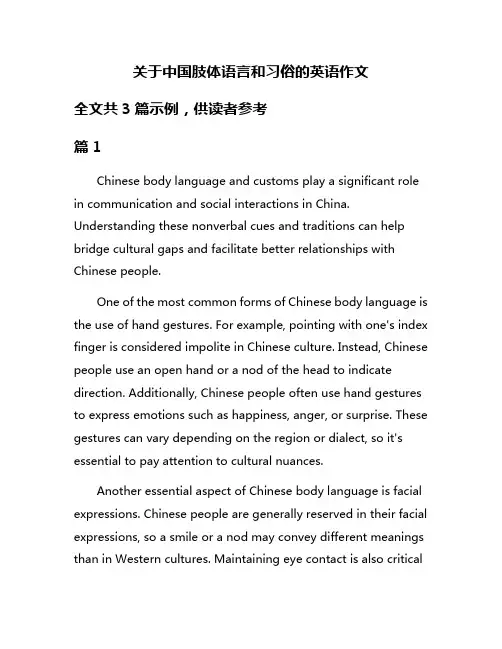
关于中国肢体语言和习俗的英语作文全文共3篇示例,供读者参考篇1Chinese body language and customs play a significant role in communication and social interactions in China. Understanding these nonverbal cues and traditions can help bridge cultural gaps and facilitate better relationships with Chinese people.One of the most common forms of Chinese body language is the use of hand gestures. For example, pointing with one's index finger is considered impolite in Chinese culture. Instead, Chinese people use an open hand or a nod of the head to indicate direction. Additionally, Chinese people often use hand gestures to express emotions such as happiness, anger, or surprise. These gestures can vary depending on the region or dialect, so it's essential to pay attention to cultural nuances.Another essential aspect of Chinese body language is facial expressions. Chinese people are generally reserved in their facial expressions, so a smile or a nod may convey different meanings than in Western cultures. Maintaining eye contact is also criticalin Chinese culture, as it demonstrates respect and attentiveness. However, excessive eye contact can be seen as confrontational or aggressive, so it's crucial to strike a balance.In addition to body language, understanding Chinese customs and traditions is crucial for building successful relationships in China. For example, gift-giving is a significant part of Chinese culture and is often used to express gratitude or establish goodwill. When offering a gift, it's essential to use both hands and present it with humility and respect. Additionally, refusing a gift multiple times before accepting it is a common practice in China to show politeness and humility.Another essential custom in China is the importance of saving face. Chinese people value honor, reputation, and social status, so it's essential to avoid causing embarrassment or shame in social situations. Criticizing someone in public or contradicting them directly can be seen as disrespectful and damaging to relationships. Instead, it's advisable to address conflicts privately and with tact.Furthermore, respecting hierarchy and authority is essential in Chinese culture. Addressing elders or superiors with proper titles and using formal language demonstrates respect and deference. Giving and receiving business cards with both handsand reading them carefully before putting them away is also a common practice in Chinese business culture.Overall, Chinese body language and customs play a vital role in communication and social interactions in China. By understanding and respecting these nonverbal cues and traditions, foreigners can build stronger relationships and navigate cultural differences effectively. Embracing Chinese customs and adapting to local norms can help bridge cultural gaps and foster mutual understanding and respect.篇2Chinese body language and customs play a significant role in communication and social interactions in Chinese culture. Understanding and being aware of these gestures and customs can help individuals navigate social situations more effectively when interacting with Chinese people. In this essay, we will explore some of the key aspects of Chinese body language and customs.Firstly, body language in China is an important means of communication as it can convey a range of emotions and intentions. For example, nodding the head up and down is typically used to indicate agreement or understanding, whileshaking the head from side to side is a sign of disagreement or disapproval. In addition, maintaining eye contact during conversations is seen as a sign of respect and attentiveness in Chinese culture.Furthermore, the use of hand gestures can also convey different meanings in China. For instance, pointing with the index finger is considered rude and impolite, so it is best to use an open hand gesture to indicate directions or objects. Similarly, beckoning someone with a curling motion of the index finger is viewed as disrespectful, so it is better to use a palm-down, waving motion to attract someone's attention.In terms of social customs, there are several important practices to be aware of when interacting with Chinese people. For example, when greeting someone in China, it is customary to bow slightly or nod the head as a sign of respect. It is also important to address individuals by their title and surname, followed by a respectful form of address such as "Mr." or "Madam."Moreover, gift-giving is a common practice in Chinese culture and is often used to express gratitude or build relationships. When presenting a gift, it is important to use both hands and avoid wrapping it in white or black paper, as thesecolors are associated with funerals. Additionally, gifts should be opened in private to avoid causing embarrassment or discomfort.In conclusion, understanding Chinese body language and customs is essential for effective communication and social interactions in Chinese culture. By being aware of the different gestures and practices, individuals can show respect and build positive relationships with Chinese people. It is important to approach interactions with an open mind and willingness to learn, in order to navigate cultural differences and foster mutual understanding and respect.篇3Chinese body language and customs play a significant role in communication and social interactions in Chinese culture. Understanding and respecting these gestures and etiquette can help bridge cultural gaps and foster better relationships with Chinese people. In this essay, we will explore some common Chinese body language and customs and their meanings.Firstly, it is important to note that physical touch is not as common in China as in Western cultures. Chinese people generally do not hug or kiss when greeting each other, especiallyin formal situations. A handshake is more appropriate, but it should be gentle and brief. Bowing slightly or nodding the head is also a respectful gesture in Chinese culture.Eye contact is another important aspect of Chinese body language. In Western cultures, maintaining eye contact is a sign of confidence and honesty. However, in China, prolonged eye contact can be seen as rude or confrontational, especially when talking to someone of higher status. It is better to make occasional eye contact while speaking and lower your gaze when listening or showing respect.Hand gestures are also commonly used in Chinese communication. For example, pointing with a finger is considered impolite in Chinese culture. Instead, Chinese people often use their entire hand to gesture or point, especially when indicating a direction or location. It is also common to use hand signals to communicate numbers, as the Chinese language has different hand gestures for numbers from one to ten.In addition to body language, there are many customs and traditions in Chinese culture that are important to observe. For example, gift-giving is a common practice in China, especially during holidays and special occasions. When giving a gift, it is customary to present it with both hands and to refuse the gift atleast once before accepting it. This shows humility and respect for the giver.Another important custom in Chinese culture is the concept of "saving face." This means avoiding embarrassment or causing shame to oneself or others. Chinese people often go to great lengths to avoid losing face, whether in business dealings, social interactions, or personal relationships. It is important to be sensitive to this cultural value and avoid criticism or confrontation in public.Furthermore, respecting elders and showing deference to authority are key principles in Chinese etiquette. Younger generations are expected to listen to and follow the advice of their elders, as they are seen as wise and experienced. When addressing someone older or of higher status, it is common to use formal titles and to show respect through gestures and tone of voice.In conclusion, Chinese body language and customs play a significant role in communication and social interactions in Chinese culture. By understanding and respecting these gestures and etiquette, we can build stronger relationships and bridge cultural gaps with Chinese people. Whether through hand gestures, eye contact, or gift-giving, it is important to be mindfulof the cultural nuances that shape Chinese communication and behavior. Let us embrace these differences and learn to appreciate the rich tapestry of Chinese culture.。
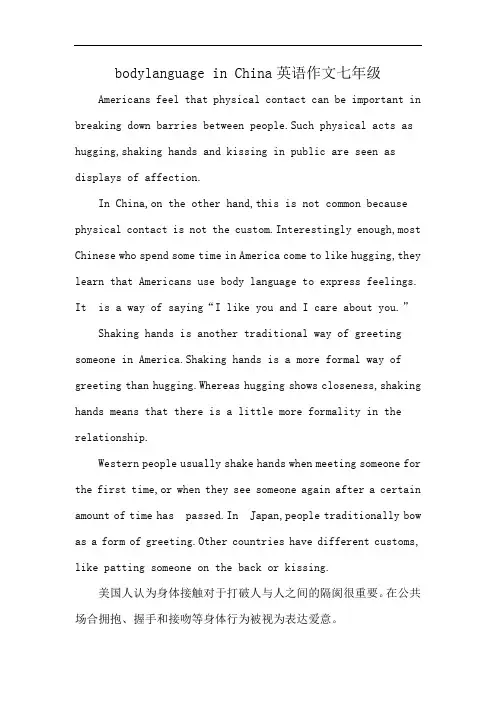
bodylanguage in China英语作文七年级Americans feel that physical contact can be important in breaking down barries between people.Such physical acts as hugging,shaking hands and kissing in public are seen as displays of affection.In China,on the other hand,this is not common because physical contact is not the custom.Interestingly enough,most Chinese who spend some time in America come to like hugging,they learn that Americans use body language to express feelings. It is a way of saying“I like you and I care about you.”Shaking hands is another traditional way of greeting someone in America.Shaking hands is a more formal way of greeting than hugging.Whereas hugging shows closeness,shaking hands means that there is a little more formality in the relationship.Western people usually shake hands when meeting someone for the first time,or when they see someone again after a certain amount of time has passed.In Japan,people traditionally bow as a form of greeting.Other countries have different customs, like patting someone on the back or kissing.美国人认为身体接触对于打破人与人之间的隔阂很重要。
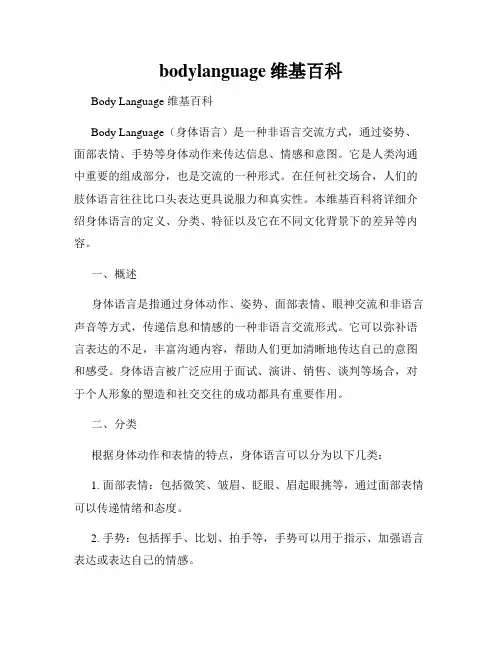
bodylanguage维基百科Body Language 维基百科Body Language(身体语言)是一种非语言交流方式,通过姿势、面部表情、手势等身体动作来传达信息、情感和意图。
它是人类沟通中重要的组成部分,也是交流的一种形式。
在任何社交场合,人们的肢体语言往往比口头表达更具说服力和真实性。
本维基百科将详细介绍身体语言的定义、分类、特征以及它在不同文化背景下的差异等内容。
一、概述身体语言是指通过身体动作、姿势、面部表情、眼神交流和非语言声音等方式,传递信息和情感的一种非语言交流形式。
它可以弥补语言表达的不足,丰富沟通内容,帮助人们更加清晰地传达自己的意图和感受。
身体语言被广泛应用于面试、演讲、销售、谈判等场合,对于个人形象的塑造和社交交往的成功都具有重要作用。
二、分类根据身体动作和表情的特点,身体语言可以分为以下几类:1. 面部表情:包括微笑、皱眉、眨眼、眉起眼挑等,通过面部表情可以传递情绪和态度。
2. 手势:包括挥手、比划、拍手等,手势可以用于指示、加强语言表达或表达自己的情感。
3. 姿势:包括站姿、坐姿、手臂交叉、颈部伸展等,姿势可以传达自信、放松或者紧张的态度。
4. 眼神交流:通过眼神的注视、眨眼频率等方式,传递友好、亲密或者厌恶的情感。
5. 非语言声音:包括笑声、哭声、叹息声等,声音也是身体语言的一种表达方式。
三、特征身体语言具有以下特征:1. 无意识性:身体语言往往是无意识地表达出来的,反映了个体内在的情感和意图。
2. 全球性:有些身体语言动作在不同文化背景下具有相似的含义,比如眨眼表示惊讶或心烦。
3. 多样性:不同文化和个体在身体语言上表达习惯和优先级存在一定的差异。
4. 综合性:身体语言常与口头语言结合使用,共同传达信息,增强沟通的效果。
四、跨文化差异身体语言在不同文化背景下存在差异,需要注意以下几点:1. 手势的含义:一些手势在不同国家可能具有不同的含义,需要了解和尊重当地的文化差异。

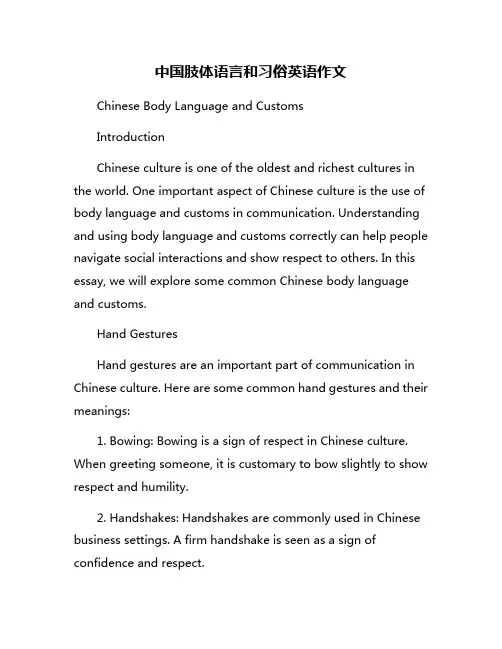
中国肢体语言和习俗英语作文Chinese Body Language and CustomsIntroductionChinese culture is one of the oldest and richest cultures in the world. One important aspect of Chinese culture is the use of body language and customs in communication. Understanding and using body language and customs correctly can help people navigate social interactions and show respect to others. In this essay, we will explore some common Chinese body language and customs.Hand GesturesHand gestures are an important part of communication in Chinese culture. Here are some common hand gestures and their meanings:1. Bowing: Bowing is a sign of respect in Chinese culture. When greeting someone, it is customary to bow slightly to show respect and humility.2. Handshakes: Handshakes are commonly used in Chinese business settings. A firm handshake is seen as a sign of confidence and respect.3. Nodding: Nodding is a universal sign of agreement, but in Chinese culture, nodding may also indicate understanding or acknowledgment.4. Pointing: Pointing with your index finger is considered rude in Chinese culture. It is better to use your entire hand to gesture towards something.Facial ExpressionsFacial expressions convey a lot of information in Chinese culture. Here are some common facial expressions and their meanings:1. Smiling: Smiling is a friendly gesture in Chinese culture. It shows warmth and friendliness.2. Frowning: Frowning is a sign of disapproval or unhappiness in Chinese culture. It is best to avoid frowning when communicating with others.3. Eye contact: In Chinese culture, maintaining eye contact is important in communication. It shows sincerity and respect.4. Blushing: Blushing is a sign of embarrassment in Chinese culture. It is seen as a sign of modesty and humility.Body PostureBody posture also plays a significant role in Chinese communication. Here are some common body postures and their meanings:1. Standing straight: Standing straight with your shoulders back is a sign of confidence and respect in Chinese culture.2. Slouching: Slouching is seen as disrespectful and unprofessional in Chinese culture.3. Crossed arms: Crossing your arms can be seen as defensive or closed off in Chinese culture. It is better to keep your arms at your sides or use gestures to communicate.4. Bowing: Bowing is a common gesture of respect in Chinese culture. It shows humility and deference to others.Etiquette and CustomsIn addition to body language, there are also important customs and etiquette to be aware of in Chinese culture. Here are some common customs and etiquette:1. Respect for elders: In Chinese culture, respect for elders is paramount. It is important to address elders with proper titles and show deference in communication.2. Gift-giving: Gift-giving is a common practice in Chinese culture. It is customary to give and receive gifts with both hands to show respect and gratitude.3. Meal etiquette: There are many rules and customs surrounding meals in Chinese culture. It is important to wait for the host to begin eating before you start, and to use chopsticks properly.4. Politeness: Politeness is highly valued in Chinese culture. It is important to use polite language and show respect to others in social interactions.ConclusionBody language and customs play a significant role in Chinese culture. By understanding and using the appropriate body language and customs, people can communicate effectively and show respect to others. By incorporating these practices into daily interactions, people can navigate social situations with ease and build strong relationships.。
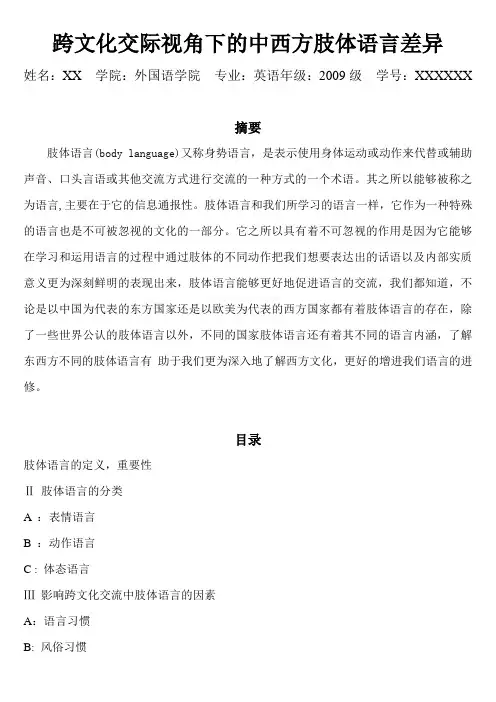
跨文化交际视角下的中西方肢体语言差异姓名:XX 学院:外国语学院专业:英语年级:2009级学号:XXXXXX摘要肢体语言(body language)又称身势语言,是表示使用身体运动或动作来代替或辅助声音、口头言语或其他交流方式进行交流的一种方式的一个术语。
其之所以能够被称之为语言,主要在于它的信息通报性。
肢体语言和我们所学习的语言一样,它作为一种特殊的语言也是不可被忽视的文化的一部分。
它之所以具有着不可忽视的作用是因为它能够在学习和运用语言的过程中通过肢体的不同动作把我们想要表达出的话语以及内部实质意义更为深刻鲜明的表现出来,肢体语言能够更好地促进语言的交流,我们都知道,不论是以中国为代表的东方国家还是以欧美为代表的西方国家都有着肢体语言的存在,除了一些世界公认的肢体语言以外,不同的国家肢体语言还有着其不同的语言内涵,了解东西方不同的肢体语言有助于我们更为深入地了解西方文化,更好的增进我们语言的进修。
目录肢体语言的定义,重要性Ⅱ肢体语言的分类A :表情语言B :动作语言C : 体态语言Ⅲ影响跨文化交流中肢体语言的因素A:语言习惯B: 风俗习惯C:价值观Ⅳ正确理解中西方肢体语言的区别和运用A:动作一样,意义不同B:意义相同,动作有差异C:只存在于美国文化中的动作D:只存在于中国文化中的动作E:对一些常见的肢体语言的理解关键词:肢体语言、跨文化交际、如何运用正文Ⅰ肢体语言的定义,重要性肢体语言 (body language)也称体态语言,是人类借助和利用自己的面部表情、手势动作、身体姿态的变化来表达和传递思想感情的方式。
运用自己的体态来表情达意几乎是人类自身的一种本能,因为它简便、迅捷、直观,在现实生活中的使用极其广泛,而且有时更能无声胜有声地巧妙表达信息并留给对方更大的想象空间。
Ⅱ肢体语言的分类1.面部表情语言(facial expression language)在跨文化交流中,面部表情语言指的是在交流的过程中通过面部的一系列动作,来传达出我们内心的真实想法,不同国家的人民之间存在着语言障碍,但是通过面部的千变万化的表情我们可以相互了解对方的意愿,他的喜、怒、哀、乐,悲、恐、惊。
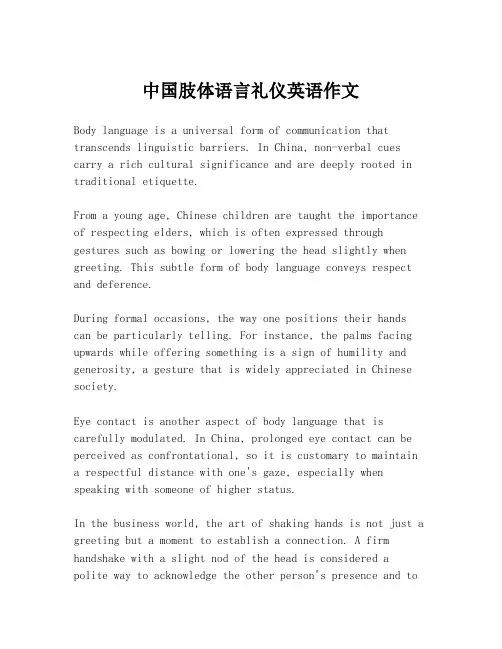
中国肢体语言礼仪英语作文Body language is a universal form of communication that transcends linguistic barriers. In China, non-verbal cues carry a rich cultural significance and are deeply rooted in traditional etiquette.From a young age, Chinese children are taught the importance of respecting elders, which is often expressed through gestures such as bowing or lowering the head slightly when greeting. This subtle form of body language conveys respect and deference.During formal occasions, the way one positions their hands can be particularly telling. For instance, the palms facing upwards while offering something is a sign of humility and generosity, a gesture that is widely appreciated in Chinese society.Eye contact is another aspect of body language that is carefully modulated. In China, prolonged eye contact can be perceived as confrontational, so it is customary to maintain a respectful distance with one's gaze, especially when speaking with someone of higher status.In the business world, the art of shaking hands is not just a greeting but a moment to establish a connection. A firm handshake with a slight nod of the head is considered apolite way to acknowledge the other person's presence and toshow readiness for a professional interaction.However, the most iconic Chinese gesture is perhaps the waving of hands with palms facing outwards to say goodbye. It's a graceful way to end a conversation, signaling a peaceful departure and leaving a positive impression.Understanding these subtleties of Chinese body language can greatly enhance one's ability to communicate effectively and respectfully in this culturally rich environment. It's not just about words; it's about the silent messages that speak volumes.。
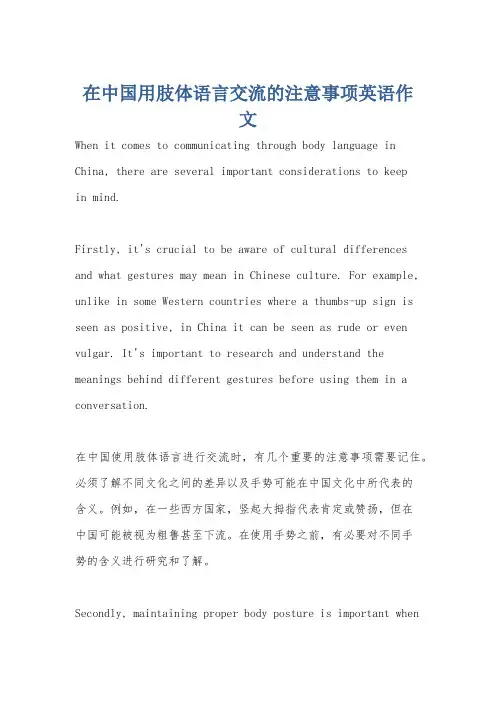
在中国用肢体语言交流的注意事项英语作文When it comes to communicating through body language in China, there are several important considerations to keepin mind.Firstly, it's crucial to be aware of cultural differences and what gestures may mean in Chinese culture. For example, unlike in some Western countries where a thumbs-up sign is seen as positive, in China it can be seen as rude or even vulgar. It's important to research and understand the meanings behind different gestures before using them in a conversation.在中国使用肢体语言进行交流时,有几个重要的注意事项需要记住。
必须了解不同文化之间的差异以及手势可能在中国文化中所代表的含义。
例如,在一些西方国家,竖起大拇指代表肯定或赞扬,但在中国可能被视为粗鲁甚至下流。
在使用手势之前,有必要对不同手势的含义进行研究和了解。
Secondly, maintaining proper body posture is important whencommunicating non-verbally. In Chinese culture, it is seen as respectful to maintain an upright and open postureduring conversations. Slouching or crossing your arms maybe interpreted as disinterest or disrespect. By being mindful of your body posture, you can convey a sense of attentiveness and engagement in the conversation.在非语言交流中保持正确的身体姿势是很重要的。

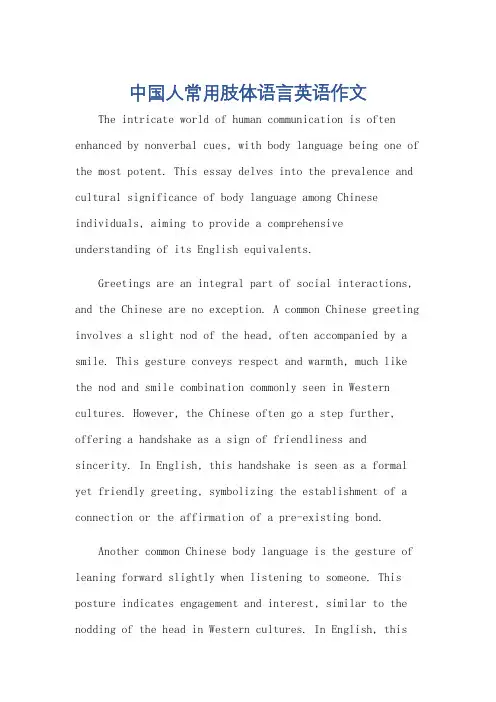
中国人常用肢体语言英语作文The intricate world of human communication is often enhanced by nonverbal cues, with body language being one of the most potent. This essay delves into the prevalence and cultural significance of body language among Chinese individuals, aiming to provide a comprehensive understanding of its English equivalents.Greetings are an integral part of social interactions, and the Chinese are no exception. A common Chinese greeting involves a slight nod of the head, often accompanied by a smile. This gesture conveys respect and warmth, much like the nod and smile combination commonly seen in Western cultures. However, the Chinese often go a step further, offering a handshake as a sign of friendliness and sincerity. In English, this handshake is seen as a formal yet friendly greeting, symbolizing the establishment of a connection or the affirmation of a pre-existing bond.Another common Chinese body language is the gesture of leaning forward slightly when listening to someone. This posture indicates engagement and interest, similar to the nodding of the head in Western cultures. In English, thisleaning forward is interpreted as active listening, showing that the listener is engaged, attentive, and understanding. During conversations, Chinese people often use hand gestures to emphasize their points. For instance, waving the hand in the air can signify excitement or emphasis, much like the raised eyebrows in English. This gesture is seen as a way to add emphasis to spoken words, making the communication more vivid and engaging.The Chinese also use hand gestures to indicate size, distance, or direction. For instance, when describing something big, they often extend their arms outward, palms up, to indicate size. In English, this gesture is similar to the use of hands when saying "big" or "large,"indicating the relative size of the object being described. In terms of personal space, the Chinese tend to maintain a closer proximity to others than Westerners, reflecting a culture that values closeness and connection. This closeness is reflected in their body language, with touches on the arm or shoulder often seen as friendly and endearing. In English, such touches are generallyconsidered more intimate and may be perceived as affectionate or consoling, depending on the context.Posture also plays a significant role in Chinese body language. Standing tall with the chest out and shoulders back is seen as a sign of confidence and authority. This posture is similar to the upright stance commonly associated with power and confidence in Western cultures. Conversely, slouching or hunching over is often interpreted as a sign of shyness or humility, much like the lowered gaze and head in Western cultures.In conclusion, body language is a universal form of communication that varies significantly across cultures. The Chinese, with their unique cultural background and social norms, have developed a rich and nuanced body language that is both distinct and recognizable. Understanding these gestures and their English equivalents can enhance cross-cultural communication, fostering deeper understanding and connections between people from different backgrounds.。
退荐中国肢体语言英语作文In China, non-verbal communication is as rich as its spoken language. A slight nod or a wave of the hand canconvey a multitude of messages, from agreement to respect.Gestures play a vital role in Chinese culture, often complementing or even substituting for spoken words. For instance, pointing with an index finger is considered rude,so people tend to use an open hand to indicate direction.Eye contact, while important, is used with caution. Prolonged eye contact can be perceived as confrontational, so Chinese individuals often avert their gaze to show humilityor respect, especially when speaking with elders or superiors.Personal space is another aspect of Chinese body language. Standing close to someone during a conversation is common, reflecting a sense of closeness and intimacy among friendsand family.The art of silence is also a form of non-verbal communication in China. It can be a sign of contemplation, respect for the speaker, or even an indirect way ofexpressing disagreement without causing offense.Facial expressions in China are nuanced and can subtly communicate emotions that are not explicitly stated. A slight smile can mask disappointment, while a furrowed brow mightindicate deep thought rather than anger.Understanding and adapting to these non-verbal cues is essential for anyone wishing to navigate social interactions in China effectively. It enriches the experience and fosters a deeper connection with the local culture.。
推荐中国肢体语言英语作文Title: Gestures and Body Language in Chinese CultureIn the rich tapestry of human communication, body language plays a pivotal role, especially in cultures as ancient and diverse as China's. Chinese body language is a fascinating blend of tradition, etiquette, and expressiveness that can offer insights into the Chinese psyche and way of life. In this essay, I will explore some common Chinese gestures and their significance within both Chinese society and cross-cultural interactions.One of the most recognizable Chinese gestures is the "waving palm down" hand movement, often used to beckon someone. Unlike the Western practice of waving with the palm facing up, the Chinese wave with the palm down, fingers moving in a scratching motion. This gesture is believed to have originated from the need to avoid pointing at people directly, which is considered rude in Chinese culture. It is a subtle yet significant difference that can lead to misunderstandings when foreigners attempt to call over a waiter or friend without being aware of this cultural nuance.Another notable gesture is the act of cupping one's fist inside the other hand while bowing slightly, known as the "baibai." This traditional form of greeting is still practiced today, particularly in formal settings or during festivals like the Lunar New Year. The baibai conveys respect and humility, reflecting the Confucian values of propriety and harmony that underpin much of Chinese social interaction.The use of silence and facial expressions also holds great importance in Chinese communication. A slight nod, a raised eyebrow, or a pursed lip can carry as much meaning as words themselves. For instance, maintaining eye contact for too long may be perceived as aggressive, whereas averting the gaze can signify deference or modesty. Understanding these silent cues is crucial for building rapport and avoiding unintended offense.In my personal experience, I recall attending a business meeting in Shanghai where a foreign colleague inadvertently offended our hosts by crossing his legs and pointing the sole of his shoe towards them. Although such behavior might be acceptable in his home country, it was deeply disrespectful according to Chinese customs, as feet and shoes are seen as unclean. This incident underscores the importance of beingmindful of body language norms when engaging with different cultures.In conclusion, Chinese body language is a complex and nuanced aspect of communication that reflects the country's deep-rooted traditions and social mores. As globalization continues to bring people closer together, awareness and sensitivity towards these nonverbal cues become increasingly vital. By learning to interpret and adapt to various forms of body language, we can foster greater understanding and cooperation across cultures, ensuring that our interactions are respectful, meaningful, and mutually beneficial.。
Body Language in China 中国人的肢体语言(2010-04-13 18:39:56)标签:chinese teacher in shanghai body language learning分类:Learning.ChineseBody language is an important part of nonverbal communication and it is connected with culture. In order to make successful exchange in multi-cultural communication, we should know the body language from different cultures. Sometimes the same body language has different meanings in different cultures and has different social functions.Americans often touch their temples to express somebody’s cleverness. But this action means there is something wrong with one’s mind or one is stupid to Chinese. Chinese are often surprised to see Americans lay their hands on their necks when they are full. Because it is an suicide action to Chinese, who used to express fullness by patting their stomachs.People from English-speaking countries turn around their rings constantly to show nervousness or uneasiness. Now people from Taiwan and Hong Kong also have this gesture. But if people in the mainland of China act like this, they will be regarded they are showing off richness.According to Chinese tradition, people who are sitting have right to take charge of others: Monarch sits and officer stands; father sits and son stands; leader sits and employee stands and so on. So the younger give the old a seat to show respect. But in America and Britain, people who are in charge of others have tendency to stand. They will make use of the height of space to indicate the high status.American’s informalness is famous. Teachers can sit on the platform or desk when they are teaching. And the students needn’t to sit straight. But in China, people are required to have a good manner.In China, people greet with each other with head nodding, smile, hand shaking and so on. Even good friends just hold hands for a short time or hammer softly on the other friend’s shoulder. Nowadays, hand shaking has become a custom to show hospitality and friendliness in many countries. But the way of hand shaking is a little different.In English speaking countries, people used to hug or kiss each other in public between males and females, which is unacceptable and only exists between lovers and couples in private in China. In America, common friends and acquaintances will avoid body touch. Even in the elevator, body touch is not allowed. Touching the other people slightly or unconsciously, people will say “Sorry”, “Very Sorry”, “Excuse me” in a hurry to express apology. Or they will be abused. In western countries, people particularly mind their private space, which often represents people’s privacy and intimacy. But Chinese pay less attention to their private space. It is crowded in China because of a large population. So Chinese have got used to it and they often show their understanding and tolerance.It is common to see youth of the same sex hold hands and hug in China. But in English speaking countries, it will be regarded homosexuality.In China, people will give chrysanthemum to the patient. But French people never do this. Becausethey think chrysanthemum is used in funerals.In many cultures, smiles are signs of happiness or friendliness, like America and China. We will find out others will return a smile to the person who is smiling at them but will turn away or stop talking with the person who are pulling a long face. “When we are speaking English, it is generally good to smile at your listener from time to time, especially when he has made an interesting comment. Also nodding your head up and down to show you are really interested in it. From time to time, you can add a sound of agreement, such as “Uh huh” or even just “mmmm”, to show you are listening.”A foreigner broke a dish in a restaurant and felt embarrassed. But Chinese who were on the spot smiled at him, which made him angrier. In fact, this smile means “Never mind”. Another facial expression is stretching out one’s tongue. When Chinese realize that their behavior is unsuitable and feel embarrassed, they often stretch out their tongues and shrink their necks at the same time, especially girls and children. But Americans never do it. They think it is rude.Head nodding often means agreement or greeting in most countries. And shaking one’s head often means disagreement or “No”. Applauding means appreciation or agreement and so on. If a person is hurt, he/she will cry to express painfulness. And we smile when are happy. Waving one’s hand means goodbye. Even some Chinese and English expressions and their meanings are totally same. For example, patting on the back means encouragement and appreciation. Pulling a long face indicates unhappiness and anger. Being all smile means happiness, standing with folded arms means indifference and so on.Nowadays, with the development of the world, people from different cultures communicate more and more often. We have more chance to exchange culture and economy. The expert, Mcluhan compare the world to “global village” to describe the world, which means the world becoming smaller and smaller because of more and more communication. On the one hand, people from east world have accepted the body language from west world, such as thumbing a ride, shrugging, “OK” gesture, “V” gesture and so on. On the other hand, with rapid development of East Asia and Southeast Asia, the body language from east world has a great influence on that of the west world. In the communication of east and west people, many westerners have learned Chinese customs and etiquettes.As an idiom goes “When in Rome, do as the Romans do.” It is the main principle in communication. This principle refers that communicators should respect and understand the culture of the other nations and eliminate the interference of their own cultures. According to this principle, we should know the differences of their customs, beliefs and their connotations of body language.。